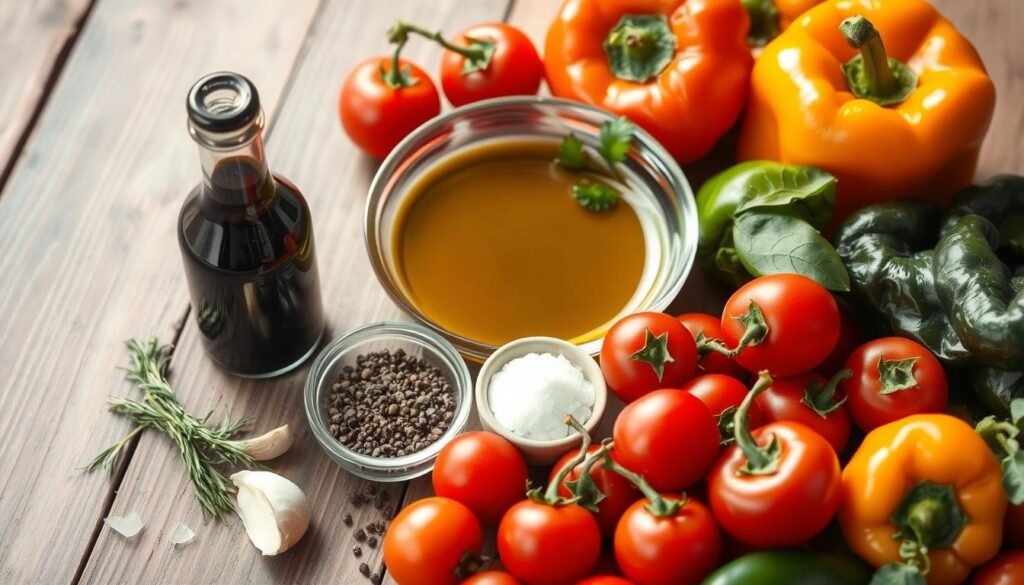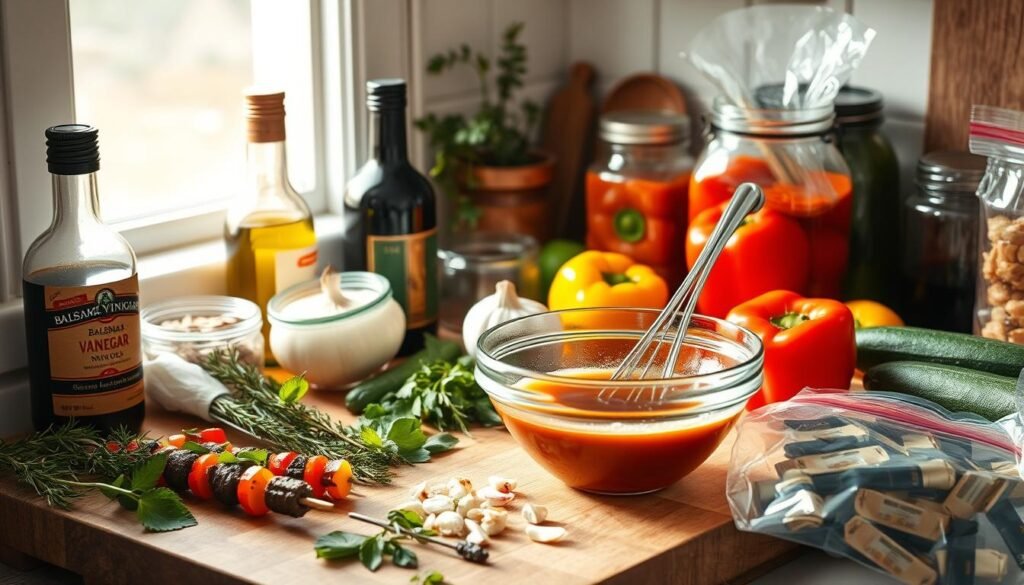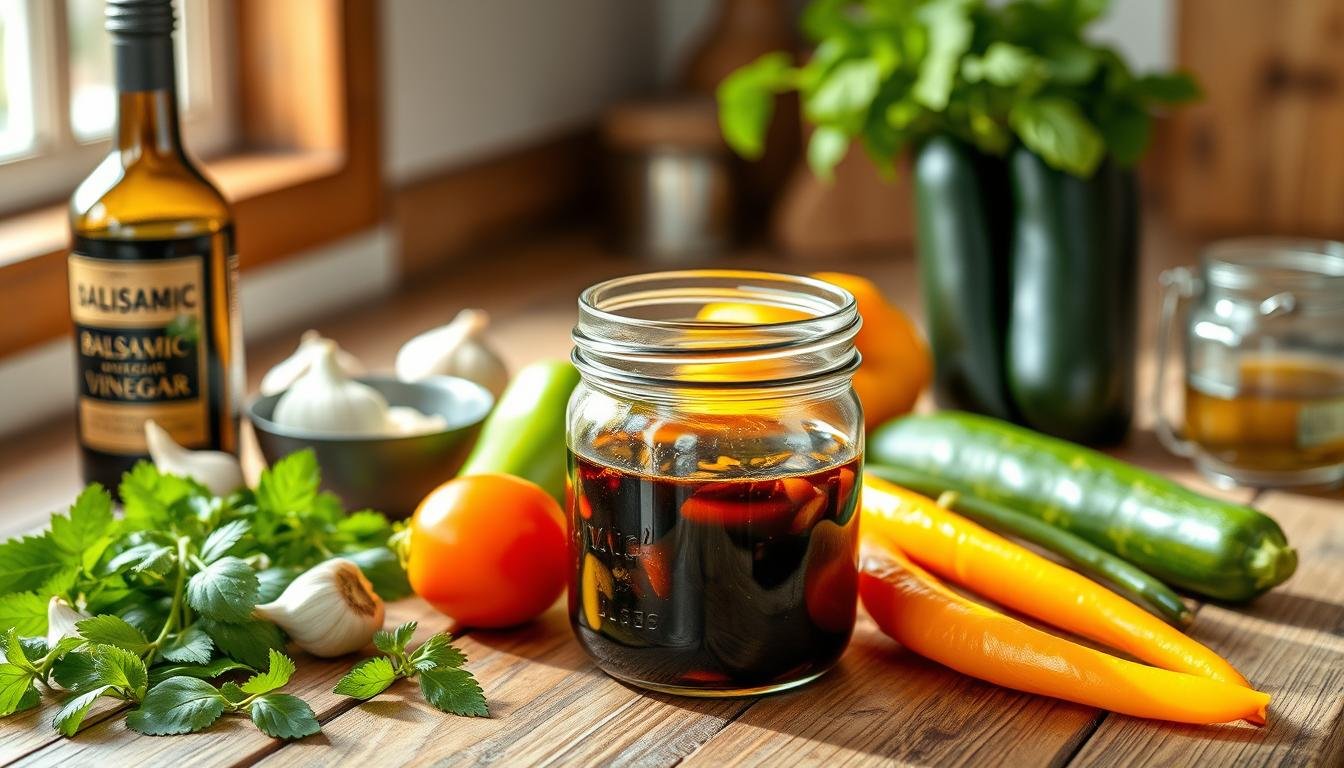Balsamic Marinade: A Versatile Flavor Booster for Cooking
Discover the magic of balsamic marinade, a flavor enhancer that makes meals special. It turns simple dishes into memorable ones. This technique adds depth to chicken, vegetables, salads, and even desserts.
With balsamic marinade, you can make dishes that taste like they came from a restaurant. Just mix olive oil, balsamic vinegar, and some spices. Your meals will get a sophisticated taste that will wow everyone.
Need a quick dinner or want to impress at a BBQ? Balsamic marinade is your go-to. It tenderizes meat and adds amazing flavor. It’s a key skill for any home cook.
Table of Contents
Understanding the Magic of Balsamic Marinade
Balsamic vinegar turns simple cooking into a journey of flavors. This ancient ingredient adds depth and complexity to your meals. It makes ordinary dishes into unforgettable experiences.
What Makes Balsamic Vinegar Special
Balsamic vinegar is more than just a condiment. It comes from medieval Italy and ages for up to 50 years. This aging process gives it a unique flavor:
- Protected Geographical Indication status
- Complex flavor development through aging
- Natural grape must as the primary ingredient
The Science Behind Marinades
Marinade science is all about chemistry in the kitchen. When you mix balsamic vinegar with proteins, amazing things happen:
- Enzymatic tenderization breaks down muscle fibers
- Acidic components enhance flavor penetration
- Sugars promote caramelization during cooking
Benefits of Using Balsamic Marinade
Balsamic marinade does more than just add flavor. It offers many benefits:
| Benefit | Description |
|---|---|
| Nutritional Value | Reduces heart disease and cancer risk via antioxidants |
| Flavor Depth | Adds complex, tangy-sweet notes to dishes |
| Tenderization | Softens proteins through natural acidic properties |
“Balsamic vinegar doesn’t just season food; it tells a story of tradition, science, and culinary artistry.” – Culinary Expert
Essential Ingredients for the Perfect Balsamic Marinade
Making a tasty balsamic marinade starts with picking top-notch ingredients. These ingredients work together to boost your dish’s taste. A great marinade has a perfect mix of flavors.
The key to a fantastic marinade is its ingredients. Let’s look at what makes this marinade stand out:
- Balsamic Vinegar: The main ingredient that gives a tangy base
- Olive oil for moisture and smooth texture
- Fresh garlic for depth and aromatic complexity
- Herbs to add layers of flavor
“The secret to an outstanding marinade is balance and quality ingredients.” – Professional Chef
Choose a high-quality aged balsamic vinegar for the best taste. Use extra virgin olive oil for its rich flavor. Fresh garlic cloves will give a stronger taste than dried garlic.
| Ingredient | Quantity | Purpose |
|---|---|---|
| Balsamic Vinegar | 3 tbsp | Provides tangy base and tenderizes meat |
| Olive Oil | 3 tbsp | Adds moisture and helps distribute flavors |
| Garlic | 2 cloves | Introduces aromatic depth |
| Fresh Herbs | 2 tbsp | Enhances overall flavor profile |
Knowing each ingredient’s role helps you make a balsamic marinade that changes simple meals into amazing dishes. Try different herbs to find your favorite mix.
Basic Balsamic Marinade Recipe and Preparation
Making a tasty balsamic marinade is simple. Just a few ingredients can turn regular meals into something special.
Core Recipe Components
To make the best balsamic marinade, you need these main ingredients:
- 1/4 cup olive oil
- 1/4 cup balsamic vinegar
- 1/2 teaspoon garlic powder
- 1 1/2 tablespoons Italian seasoning
- 3/4 teaspoon salt
- 1/2 teaspoon black pepper
Step-by-Step Mixing Instructions
Here’s how to mix your balsamic marinade:
- Put all ingredients in a non-reactive bowl
- Whisk well to mix everything together
- Let it sit for 5 minutes to blend the flavors
“A great marinade is all about balance and letting ingredients speak for themselves.” – Culinary Chef
Storage and Shelf Life Tips
Keeping your balsamic marinade fresh is important. Store it in an airtight container in the fridge for up to 5 days. You can also freeze it for up to 3 months.
Here are some important tips for using the marinade:
- Always marinate in the fridge
- Use it within the recommended time
- Don’t reuse marinade that’s been with raw meat
Pro tip: This recipe makes enough marinade for 1 to 4 pounds of meat. It’s great for many cooking needs.
Flavor Enhancers and Optional Additions

To make your balsamic marinade truly stand out, use the right flavor enhancers. The perfect mix of herbs and spices can turn a simple recipe into a work of art.
Begin by looking at classic herbs and spices that go well with balsamic vinegar:
- Rosemary: Adds an earthy, pine-like depth
- Thyme: Provides subtle, aromatic undertones
- Red pepper flakes: Introduces a gentle heat
- Oregano: Brings Mediterranean zest
Sweeteners are key in balancing the vinegar’s tartness. Brown sugar and honey are great choices. They soften the vinegar’s sharpness and add depth.
“The secret to a perfect marinade is finding balance between acid, oil, herbs, and sweetness.” – Professional Chef
When picking sweeteners, consider these:
- Brown sugar: Adds caramel-like richness
- Honey: Provides natural sweetness
- Maple syrup: Introduces unique depth
Try different herbs and spices to make a marinade that’s all your own. The aim is to boost the flavors, not to overwhelm them.
Best Meats to Pair with Balsamic Marinade
Balsamic marinades make meats taste amazing. They turn simple dishes into special meals. Let’s find out which meats pair best with balsamic marinades.
Poultry Perfection: Balsamic Marinade for Chicken
Chicken gets a big flavor boost from balsamic marinades. It works well for boneless breasts or whole roasted birds. Marinate chicken for 2 hours to overnight for the best taste.
- Chicken breasts absorb marinade quickly
- Thighs benefit from longer marinating times
- Whole roasted chickens get a beautiful caramelized finish
Sizzling Steak with Balsamic Magic
Steak fans will love balsamic marinades. They make your favorite cuts taste like gourmet food. Flank steak is a standout, getting tender and flavorful. Marinate for 2 hours, using ¼ to ½ cup of marinade per pound.
| Steak Cut | Marinating Time | Recommended Cooking Temperature |
|---|---|---|
| Flank Steak | 2-8 hours | 135°F (Medium-Rare) |
| Ribeye | 1-4 hours | 130-135°F |
| Sirloin | 2-6 hours | 140°F (Medium) |
Pork and Lamb: Balsamic Marinade Masterpiece
Pork and lamb love balsamic marinades. The sweet-tangy taste complements their rich flavors. Lamb chops and pork tenderloin become super tender with the right balsamic mix.
Pro tip: Always allow your meat to rest for 10 minutes after cooking to lock in those delicious juices!
Every meat reacts differently to balsamic marinades. Try different cuts and marinating times to find your favorite flavors.
Marinating Times and Techniques
Learning the right marinating time is key to getting the best flavors in your food. Each protein needs a special marinating method for the best taste and texture.

Knowing the best marinating times can change your cooking game. Here’s a detailed guide to help you master your marinade skills:
| Protein Type | Optimal Marinating Time |
|---|---|
| Seafood | 15-30 minutes |
| Chicken | 1-4 hours |
| Pork | 3-12 hours |
| Beef | 4-24 hours |
| Vegetables | 15-30 minutes |
Important marinade techniques to keep in mind:
- Always marinate in a non-reactive container or zip-top bag
- Refrigerate while marinating to prevent bacterial growth
- Turn the food periodically for even flavor distribution
- Remove excess marinade before cooking to achieve proper browning
Pro tip: Never reuse marinade that has been in contact with raw meat to avoid cross-contamination.
For the best flavor, use these recommended ratios:
- 1/2 cup Extra Virgin Olive Oil
- 1/4 cup Balsamic Vinegar
- 1-2 tablespoons honey or brown sugar
- 3-4 minced garlic cloves
- Fresh herbs to taste
Remember, marinating is an art that requires patience and practice. The right technique can elevate your dishes from ordinary to extraordinary!
Cooking Methods for Balsamic Marinated Foods
Trying different cooking methods can make your balsamic marinated dishes amazing. Each way brings out special flavors and textures in your favorite foods. This ensures a tasty meal every time.
Grilling Balsamic Marinated Foods
Grilling balsamic marinated foods needs skill and precision. First, heat your grill to 500 degrees Fahrenheit for the best sear. Grill chicken for 3-4 minutes on each side, until it reaches 165 degrees Fahrenheit inside.
- Preheat grill to high temperature
- Pat meat dry before grilling
- Avoid direct flame contact with marinade
- Use tongs for safe meat handling
Oven Roasting with Balsamic
Oven roasting is a steady way to cook balsamic marinated meats. Heat your oven to 450 degrees Fahrenheit. Cook each side for about 5 minutes. Then, a minute under the broiler adds a nice caramelized crust.
Pan-Searing Techniques
Pan-searing lets you control the heat and flavor. Use a heavy skillet and cook over medium-high heat. Make sure the pan is hot before adding your marinated protein for a perfect crust.
“The secret to perfect pan-searing is patience and high heat” – Professional Chef
Remember, no matter the cooking method, let your meat rest for 5-7 minutes after cooking. This helps keep it juicy and full of flavor.
Vegetarian and Plant-Based Applications
Balsamic marinade for vegetables makes plant-based dishes amazing. It opens up a world of tasty possibilities for tofu and tempeh.
Plant-based marinades add depth and complexity to vegetarian cooking. It’s important to know how different ingredients absorb flavors.
- Tofu marinades benefit from longer absorption times
- Tempeh handles stronger flavor profiles
- Delicate vegetables require gentler marinating techniques
Nutritional insights for plant-based balsamic marinade show its versatility:
| Ingredient | Serving Size | Calories | Marination Time |
|---|---|---|---|
| Tofu | 91.5g | 153 kcal | 1-24 hours |
| Tempeh | 100g | 195 kcal | 2-4 hours |
| Mixed Vegetables | 150g | 75 kcal | 30-60 minutes |
Pro tip: Always refrigerate while marinating to maintain food safety and enhance flavor absorption.
“Balsamic marinades are the secret weapon for elevating plant-based cuisine to gourmet levels.” – Culinary Expert
When using balsamic marinade, think about texture and density. Tempeh can handle acidic marinades, but tofu needs a gentler touch. Vegetables soak up flavors fast, so watch the marinating time.
Good balsamic marinade ingredients for plant-based dishes include:
- Extra virgin olive oil
- High-quality balsamic vinegar
- Fresh herbs
- Minced garlic
- Dijon mustard
With these tips, you can turn simple plant-based ingredients into dishes that are both flavorful and nutritious.
Common Mistakes to Avoid When Using Balsamic Marinade
Mastering balsamic marinade means knowing what to avoid. The right techniques can make your dishes taste amazing. But, mistakes can ruin the flavor and make food unsafe.
To avoid marinade mistakes, pay close attention to a few important things:
Timing Challenges in Marination
Getting the marinating time wrong can mess up your dish’s texture and taste. Each protein needs a different marinating time:
- Chicken breast: 1-2 hours maximum
- Fish: 15-30 minutes
- Beef: 2-24 hours
- Vegetables: 30 minutes to 2 hours
Ingredient Ratio Precision
Getting the right mix of marinade ingredients is key for great flavor. Here’s what to do:
| Ingredient | Recommended Ratio |
|---|---|
| Oil | 1/4 cup |
| Balsamic Vinegar | 1/4 cup |
| Salt | 1 teaspoon per 1/2 cup liquid |
Storage and Safety Considerations
Food safety is very important when using marinades. Here are some storage tips:
- Always marinate in refrigerated conditions
- Discard marinades that have touched raw meat
- Store homemade marinades up to 3 months in sealed containers
- Boil used marinades for at least 1 minute to eliminate bacteria
“Precision in marinating transforms good cooking into exceptional cuisine.” – Culinary Expert
Remember, knowing these detailed techniques helps you avoid common marinade mistakes. This way, you can make delicious, safe meals.
Creating Balsamic Reductions and Glazes
Turning balsamic vinegar into a thick, syrupy balsamic reduction is an art. It makes your dishes better. This process needs patience and care to get the right consistency and flavor.
Making a balsamic glaze is easy. You just need a few things to make regular balsamic vinegar into a fancy sauce. This sauce can make your meals much better.
Essential Ingredients for Balsamic Reduction
- 1 cup high-quality balsamic vinegar
- 2 tablespoons brown sugar (optional)
- 1 clove minced garlic (optional)
Use a thick pot to avoid burning the vinegar. Simmer it slowly. This lets the vinegar get thicker and taste stronger.
Reduction Process
- Pour balsamic vinegar into the pot
- Add optional brown sugar for sweetness
- Simmer on medium-low heat
- Stir occasionally to prevent burning
- Reduce until mixture coats the back of a spoon
| Preparation Detail | Measurement |
|---|---|
| Prep Time | 5 minutes |
| Cook Time | 25 minutes |
| Total Yield | ½ cup balsamic glaze |
| Storage Duration | Up to 2 weeks refrigerated |
“A great balsamic reduction is about patience and understanding the transformation of flavors.” – Culinary Expert
Keep your homemade balsamic glaze in an airtight container in the fridge. Use it on roasted veggies, pizzas, salads, or to make your dishes even better.
Pro tip: Run an exhaust fan during reduction to minimize vinegar odors and ensure a pleasant cooking experience.
Conclusion
Exploring balsamic marinades opens a world of flavor that makes meals special. With just 5 minutes, you can make a marinade that adds depth to many dishes. This marinade does more than just season; it combines health with taste.
Balsamic marinades are versatile, working well with chicken and vegetables. They use balsamic vinegar’s rich flavor and health benefits. This makes them a key tool for home cooks. You’ll see how simple ingredients can make marinades that taste great and may even help your health.
Remember, cooking is a way to express yourself. What you’ve learned is just the start. Every marinade you make is a chance to try new flavors and ingredients. Use balsamic marinades to make your meals stand out, pleasing your taste buds and your health.
Now, your kitchen is ready to make tasty, healthy marinades that will wow everyone. You’ve learned how to make traditional balsamic vinegar and perfect marinating techniques. These skills will help you in many future cooking adventures.
FAQ
What makes balsamic vinegar ideal for marinades?
How long can I store a homemade balsamic marinade?
Can I use balsamic marinade for vegetarian dishes?
What are the risks of over-marinating?
How do I prevent my marinade from burning during cooking?
What’s the difference between a balsamic marinade and a balsamic reduction?
Can I use balsamic marinade on all types of meat?
Are there any health benefits to using balsamic marinades?
Source Links
- Easy Grilled Balsamic Chicken – https://www.ourhappymess.com/grilled-balsamic-chicken/
- How to use balsamic vinegar? – https://oliviersandco.com/blog/howtobalsamic?srsltid=AfmBOopiRPg6_WqkdP0HLd_2hvySakzwrmvZJA1BKUrk2FV6lDsoVJls
- Perfect Balsamic Glaze
– https://sweetandsavorymeals.com/balsamic-glaze/

